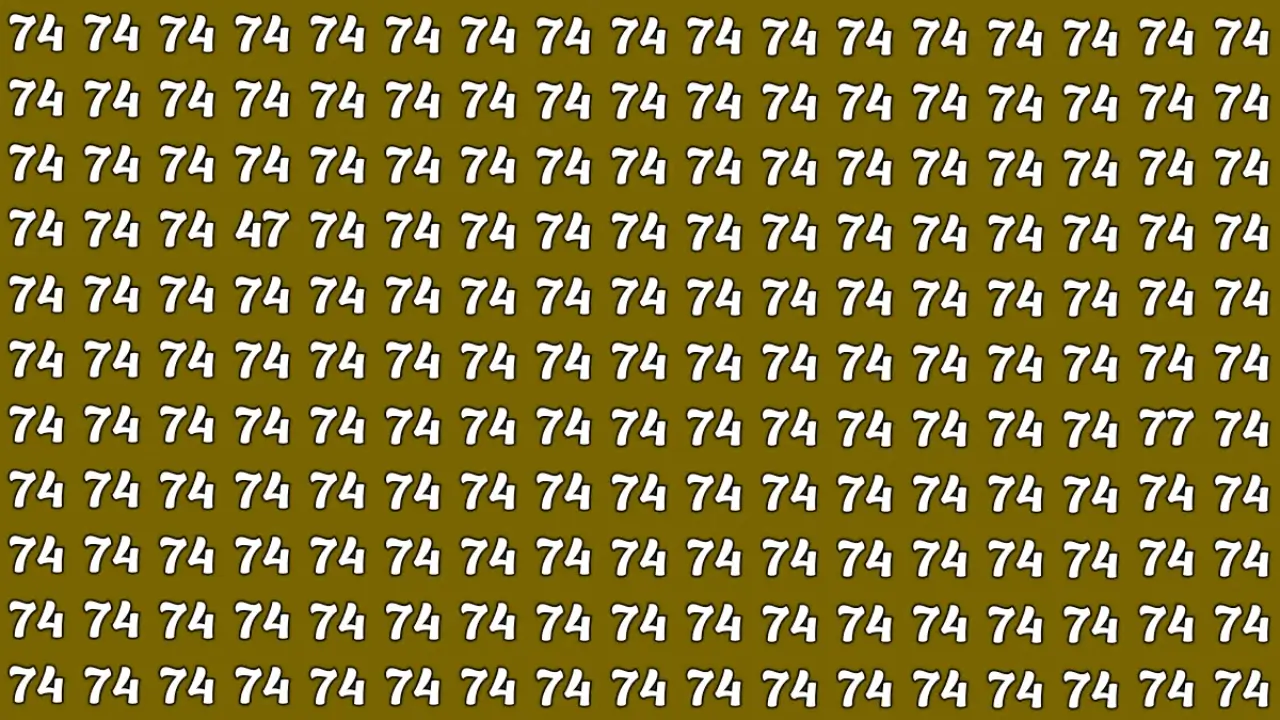Optical illusions reveal fascinating truths about the way our brains process information. They play on our reliance on patterns, similarities, and assumptions, often leaving us tricked by what we see. One such brain-teasing test trending among puzzle enthusiasts is the Optical Illusion: Spot the Number 75 and 47 Among 74.
At first glance, participants are shown dense clusters filled with the number 74, but hidden inside are rogue variations—75 and 47. While those digits differ only slightly, that minor variation is enough to confuse the mind, especially when seen among a wall of repeating numbers.
The human brain’s natural preference for pattern recognition makes this challenge a lot harder than it initially seems.
This article examines why these puzzles are difficult, the science behind optical illusions, how they sharpen mental agility, and strategies for finding hidden numbers like 75 and 47 within a sea of 74s.
Why Spotting 75 And 47 Is So Tricky Among 74
Although it sounds easy—just look for numbers different from 74—the real challenge begins when hundreds of identical 74s fill an image. The small deviations in shape between “4, 5, and 7” get lost in repetition.
Reasons it is difficult:
- Shape Similarities: Digits “4” and “7” are angular and closely related, while “5” may blend with “4” when quickly scanned.
- Pattern Overload: The repetition of 74 across rows causes automatic recognition, where the brain assumes all are the same.
- Crowding Effect: Numbers placed close together blur details, making slight differences invisible without sharp focus.
- Time Pressure: These puzzles are often used as quick challenges, increasing the difficulty of spotting outliers in seconds.
This clever design works because the brain chooses efficiency (grouping visuals) over exact precision, especially under visual overload.
Science Behind Optical Number Illusions
Spotting 75 and 47 among 74 demonstrates important principles in psychology, specifically pattern recognition and selective attention.
- Gestalt Similarity Principle: The mind groups similar patterns rather than analysing every single number individually.
- Top-Down Processing: Our brain sees what it expects—in this case, 74 everywhere—and may miss slight variations.
- Selective Attention: Requires filtering distractions to focus, but strong repetition makes filtering harder.
- Working Memory: Holding the targets “75” and “47” in mind and comparing them against thousands of 74s tests memory limits.
Thus, illusions like these highlight the brain’s limitations and strengths simultaneously.
Benefits Of Solving Number-Spotting Optical Illusions
Though designed for entertainment, puzzles like spotting 75 and 47 among 74 have many cognitive and psychological benefits:
- Enhances Focus: Forces attention on subtle differences and sharpens detail recognition.
- Improves Memory: Strengthens short-term recall by memorising target patterns.
- Boosts Patience and Perseverance: Persistence is required to find hidden variations, developing focus beyond casual glance.
- Cognitive Exercise: Keeps the brain active, flexible, and resistant to decline through mental workouts.
- Stress Release: Finding the hidden numbers creates satisfaction, activating reward centres in the brain.
In short, while puzzles are playful, their positive effects on the mind are long-lasting.
Comparing Numbers: Why 75 and 47 Confuse With 74
| Number | Structure | Why Confusion Happens Among 74s |
| 74 | Common pattern: straight 7 and angular 4 | The repeated “base” number that dominates clusters |
| 75 | 7 stays, but 4 changes to 5 | “4” and “5” shapes blend; curved 5 often overlooked |
| 47 | Reverse order of digits | The same shapes, flipped; eyes gloss over reversal in clutter |
This table shows how both 75 and 47 exploit cognitive shortcuts: one swaps a digit, the other changes the order—both subtle enough to trick the brain.
How To Spot Hidden Numbers More Efficiently
Solving number illusions is about strategy and patience. To find 75 and 47 among 74, apply the following techniques:
- Digit Anchoring: Focus specifically on the second digit to detect if it is “4” or another digit like “5” or “7.”
- Reverse Order Checking: Keep an eye out for flipped pairs, where the digits appear reversed from the dominant sequence.
- Row-By-Row Scanning: Rather than random eye movement, go line by line for systematic accuracy.
- Peripheral Scanning: Slight variations stand out more when not focusing directly, making side vision effective.
- Practice Recognition: With repeated exposure to such puzzles, the brain strengthens its anomaly detection speed.
These techniques transform a frustrating challenge into an achievable, stimulating brain workout.
Why People Love These Optical Illusions
The popularity of puzzles like “Spot 75 and 47 among 74” lies in their balance of simplicity and complexity. The task requires no prior knowledge, but success taps into deep mental processes.
People enjoy them because:
- They provide instant competition, testing speed with friends or online communities.
- They give a sense of achievement, rewarding effort with clarity.
- They are universally understandable, since numbers transcend language barriers.
- They offer training disguised as fun, blending relaxation with mental sharpening.
This mix ensures their global popularity remains enduring.
Real-Life Applications Of Difference-Spotting Skills
While seemingly playful, the skills tested by these optical illusions are incredibly practical:
- Medical Imaging: Doctors rely on noticing subtle differences to locate health anomalies.
- Quality Control: Detecting small flaws in production lines mirrors these observation skills.
- Editing and Proofing: Spotting minor misplacements or errors requires the same level of concentration.
- Surveillance and Investigation: Security professionals and detectives depend on anomaly recognition.
Thus, spot-the-difference-style illusions translate into highly valuable life skills.
FAQs
1. Why is it so tough to find 75 and 47 among 74s?
Because the digits are either reversed (47) or closely shaped (75 vs 74), the brain tends to overlook subtle variations in repetitive clusters.
2. Which number is harder to find—75 or 47?
Most find 47 more difficult because it uses the same digits as 74 but in a reversed order, which the brain often normalises.
3. Can puzzles like this genuinely improve observational skills?
Yes. They train the brain to slow down, recognise details consciously, and resist confusion from repetitive patterns.
4. How can one solve them quicker?
Scanning row by row and focusing on the digit that changes, rather than the entire number, vastly improves speed.
5. Are children also encouraged to play such puzzles?
Certainly. These puzzles strengthen concentration, problem-solving ability, and visual learning in children while also keeping them entertained.














